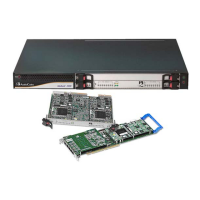Version 5.2 371 September 2007
SIP User's Manual 8. Networking Capabilities
When working in a PPPoE environment, the gateway negotiates for its IP address (as
described above). However, if you want to disable the PPPoE client, the gateway can be
configured to use default values for IP address, subnet mask and default gateway. This
can be done using ini file parameters PPPoERecoverIPAddress,
PPPoERecoverSubnetMask and PPPoERecoverDfgwAddress. These parameters indicate
to the gateway that if the PPPoE is disabled and no BootP server is activated, as required
in the gateway to use a PPPoE environment, then the gateway should use these defaults
for its IP configuration.
For a description of the ini file parameters for PPPoE, refer to 'Networking Parameters' on
page 273.
8.5 IP Multicasting
The gateway supports IP Multicasting level 1 according to RFC 2236 (i.e., IGMP version 2)
for RTP channels. The gateway is capable of transmitting and receiving Multicast packets.
8.6 Robust Reception of RTP Streams
This mechanism filters out unwanted RTP streams that are sent to the same port number
on the gateway. These multiple RTP streams can result from traces of previous calls, call
control errors, and deliberate attacks.
When more than one RTP stream reaches the gateway on the same port number, the
gateway accepts only one of the RTP streams and rejects the rest of the streams. The RTP
stream is selected according to the following procedure:
The first packet arriving on a newly opened channel sets the source IP address and UDP
port from which further packets are received. Thus, the source IP address and UDP port
identify the currently accepted stream. If a new packet arrives whose source IP address or
UDP port are different to the currently accepted RTP stream, one of the following occurs:
The gateway reverts to the new RTP stream when the new packet has a source IP
address and UDP port that are the same as the remote IP address and UDP port that
were stated during the opening of the channel.
The packet is dropped when the new packet has any other source IP address and
UDP port.
8.7 Multiple Routers Support
Multiple routers support is designed to assist the gateway when it operates in a multiple
routers network. The gateway learns the network topology by responding to Internet
Control Message Protocol (ICMP) redirections and caches them as routing rules (with
expiration time).
When a set of routers operating within the same subnet serve as gateways to that network
and intercommunicate using a dynamic routing protocol, the routers can determine the
shortest path to a certain destination and signal the remote host the existence of the better
route. Using multiple router support, the gateway can utilize these router messages to
change its next hop and establish the best path.
Note: Multiple Routers support is an integral feature that doesn’t require
configuration.

